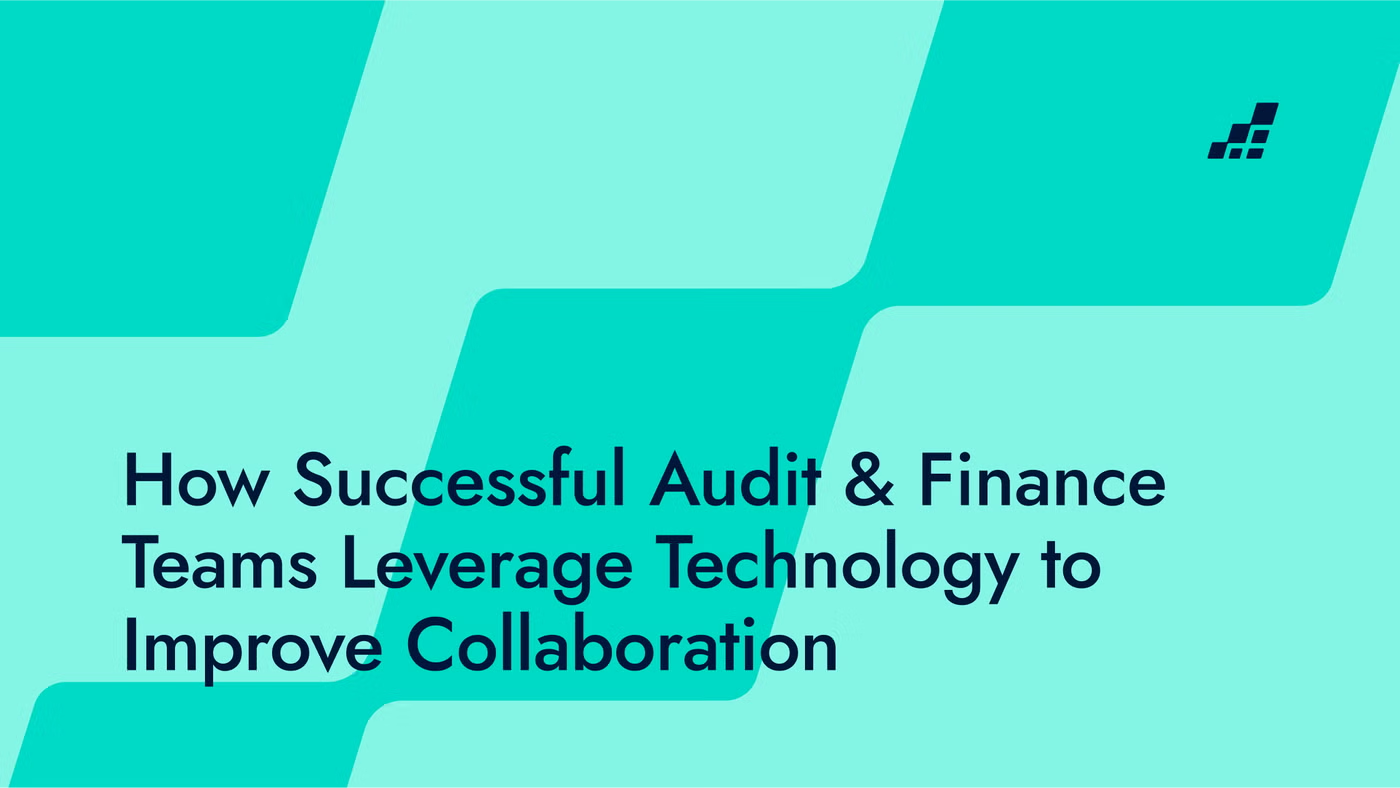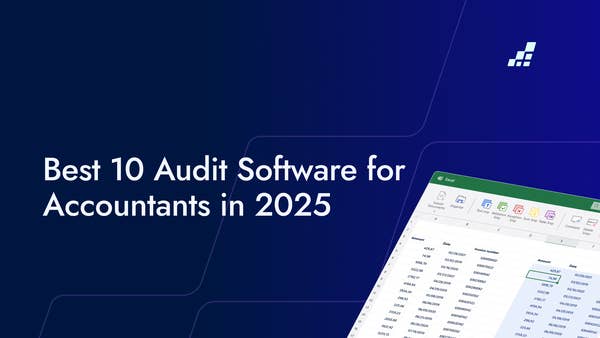- /
- Blog
How Successful Audit & Finance Teams Leverage Technology to Improve Collaboration

Collaboration is the making or breaking of any team, and audit and finance are no different.
Let’s face it: Effective collaboration across departments and functions (and even sometimes within the same team) isn’t always smooth sailing. Whether collaboration falters because of systemic issues or simply because someone always starts their sentences with “essentially” and then proceeds to say nothing essential, teamwork is challenging.
This is where the right tools and platforms can make a world of difference.
With technology that breaks down communication siloes, streamlines data handling, or provides a single source of truth, teams can transform fractured, stress-inducing “collaboration” into seamless, enjoyable collaboration.
In this article, we’ll dive into how the most successful audit and finance teams use technology to connect, communicate, and collaborate better than ever.
Why Collaboration Matters in Audit and Finance
Alright, stop, collaborate, and listen… don’t pretend you didn’t know this was coming at some point.
Audit and finance are high-stakes, so not having solid collaboration is actually an irresponsible risk that should be avoided at all costs. This isn’t supposed to be fear-mongering; it’s simply the truth.
Audit teams are responsible for thorough financial reviews and compliance checks, while finance teams focus on maintaining accurate records, forecasting, and strategizing. Each side heavily depends on the other to ensure reliable financial reporting and uphold regulatory standards.
However, with responsibilities that overlap, blur, and intertwine, staying aligned is almost a full-time job in itself. Missed updates and fragmented processes almost always lead to costly errors, regulatory issues, or even reputational damage.
Common Challenges in Collaboration
Siloed Departments
- Lack of Integration: Different teams often end up working in silos, each with their separate tools and systems that rarely talk to each other. This lack of integration can throw everyone off, leading to misaligned goals and making it tough to deliver a unified view of the data or, more problematic still, a single source of truth.
- Limited Communication: When communication channels are lacking, crucial information tends to slip through the cracks, causing delays, misunderstandings, and sometimes, missed compliance requirements.
Confusion Over Roles and Responsibilities
- Ambiguity in Task Ownership: Without clear task ownership, it’s far too easy for team members to get confused over who’s responsible for what. This can lead to duplication or, worse, gaps where tasks just don’t get done.
- Overlapping Functions: Overlapping responsibilities can mean two people are doing the same thing—or, sometimes, no one is doing it. This overlap can slow down projects and make for an awkward handoff.
Complex and Fragmented Processes
- Manual Workflows: Many audit and finance tasks are still done manually, which takes time and increases the chance of human error. These time-consuming processes often get in the way of collaboration, as teams are busy double-checking work instead of sharing insights and moving forward.
- Data Fragmentation: With data scattered across multiple systems, teams often find themselves spending more time reconciling numbers than actually collaborating. Instead of working together on strategic initiatives, everyone’s stuck matching figures from different sources.
Data Overload and Complexity
- Volume of Information: The vast amount of data that audit and finance teams handle can overwhelm them, making it difficult to focus on collaboration and strategic decision-making.
- Accuracy Concerns: The need for precise data can shift focus away from collaborative efforts as teams prioritize validating and reconciling information.
How Technology Address These Collaboration Challenges
Breaking Down Silos and Improving Communication
Technology plays a vital role in closing communication gaps in audit and finance. Platforms like Microsoft Teams and Slack provide real-time messaging, dedicated channels for projects, and instant notifications, so everyone can stay in sync and avoid critical oversights. Teams can easily share files, data, and updates within specific channels, creating an organized space for collaboration.
How Technology Helps:
- Real-time messaging keeps everyone aligned.
- Project-based channels make file-sharing easy.
- Instant alerts reduce delays in crucial discussions.
Clarifying Roles and Responsibilities
Tools like Asana and Trello help teams define tasks, set deadlines, and keep everyone on track. By assigning specific responsibilities, these platforms ensure everyone knows exactly what to do, reducing confusion and overlap. With visual timelines and progress tracking, teams can easily see who’s handling what, fostering accountability and smoother workflows. This clarity helps avoid missed tasks and boosts collaboration across the board.
How Technology Helps:
- Assign specific tasks to individual team members
- Track project milestones and completion rates in real-time
- Create clear timelines to ensure deadlines are met
Streamlining Data Handling with AI and Automation
By leveraging platforms like DataSnipper, teams can automate data extraction and verification, minimizing tedious tasks like data entry and document review. This accelerates processes and enhances accuracy, ensuring that all team members have access to reliable, up-to-date information. With streamlined workflows and reduced manual effort, teams can focus more on strategic initiatives and less on time-consuming tasks, ultimately driving productivity and better decision-making.
How Technology Helps
- Automates repetitive tasks like data extraction, reducing human error
- Streamlines the document review process for faster, more accurate results
- Enhances compliance by ensuring audit-ready records
Enhancing Access to Information
Modern data management systems, like Tableau or Power BI, make life easier for audit and finance teams by ensuring quick access to vital information. With these tools, everyone can find accurate data without the usual bottlenecks. This transparency speeds up decision-making and boosts collaboration, leading to a more efficient workflow.
How Technology Helps:
- Provides all team members with quick access to the latest documents with centralized data repositories.
- Allows teams to trace data back to its source, enhancing accountability and reducing errors with centralized systems.
- Enables collaboration by allowing access to information from anywhere with cloud-based solutions.
How to Implement Technology Effectively
When it comes to enhancing collaboration in audit and finance teams, effectively implementing technology is key. Here are some practical strategies and best practices to help you along the way:
- Assess Team Needs and Goals: Start by taking a good look at what your team really needs. What challenges are you facing, and how can technology help? Understanding your goals will guide you in selecting the right tools.
- Choose the Right Tools: It's key to pick user-friendly tools that fit well with what you're already using. And don’t forget to consider options that come with solid support and a low barrier to entry, so your team can hit the ground running while still having the potential to grow.
- Provide Training and Support: Speak about support; once you’ve got the tools in place, it’s crucial to ensure everyone knows how to use them. This could involve training sessions, one-on-one coaching, or easy-to-access resources like video tutorials. Having tech-savvy team members as champions can also make a big difference in getting everyone up to speed.
- Foster a Collaborative Culture: Create an environment that encourages teamwork and open communication. Celebrate wins and recognize team members who embody a collaborative spirit. Regular check-ins to gather feedback can help ensure everyone is comfortable with the new tools.
- Implement Gradually: Don’t overwhelm your team with too much too soon. Start small by introducing one or two tools at a time, allowing everyone to adapt before adding more. This gradual approach makes the transition smoother and less disruptive.
- Measure Success: Set up some key performance indicators (KPIs) to track how the technology is impacting collaboration. You might look at response times, project completion rates, or user satisfaction levels. Regularly reviewing these metrics can help you see what’s working and what might need a tweak.
Potential Barriers to Adoption and How to Address Them
Let’s face it: introducing new technology can come with its fair share of challenges. Common barriers include resistance to change, lack of buy-in from the team, and data security concerns. Here’s how to tackle these issues:
- Engage Stakeholders Early: Get team members involved in the decision-making process from the get-go. This can help build enthusiasm and reduce resistance to new tools.
- Communicate the Benefits: Be clear about how the new technology will improve workflows, save time, and boost collaboration. Sharing success stories from other teams can help get everyone on board.
- Provide Ongoing Support: Address any concerns that pop up and offer continuous training and resources to help everyone adjust to the new tools.
Measuring Success
To truly gauge how well your new technology is working for collaboration, focus on:
- User Adoption Rates: Keep an eye on how many team members are actively using the new tools.
- Feedback Surveys: Regularly check in with your team to gather their thoughts on the new tools. Their insights can point you to areas needing improvement.
- Performance Metrics: Look at key metrics related to project completion, data accuracy, and overall efficiency to see how the tech impacts team performance.
“It's amazing to see how quickly DataSnipper has become a part of our everyday work. Auditors can be conservative. Despite this, the fact that it's widely embraced and its effectiveness recognized shows how good DataSnipper is. It's embraced by everyone from assistants to partners, and there are few applications we can say that about.” Leon Dieleman, Audit Supervisor at Baker Tilly
Unlocking Your Team’s Full Potential
Technology is no longer just a support system—it’s the engine that drives collaboration in today’s audit and finance teams. From breaking down communication barriers and clarifying roles to improving access to real-time data, technology empowers teams to work smarter, not harder.
By embracing the right tools, audit and finance teams can boost efficiency, minimize errors, and create a more collaborative culture. So, if you’re ready to take your team’s collaboration to the next level, it’s time to tap into the power of technology! Let’s gear up and get started on this exciting journey together!
Ready to make the leap? Read our report to know technology is moving the audit and finance industry forward.
.png)

.png?width=600&quality=70&format=auto&crop=16%3A9)
